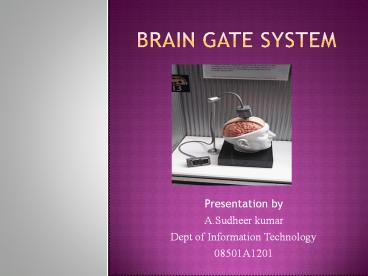BRAIN GATE SYSTEM PowerPoint PPT Presentation
Title: BRAIN GATE SYSTEM
1
BRAIN GATE SYSTEM
- Presentation by
- A.Sudheer kumar
- Dept of Information Technology
- 08501A1201
2
INTRODUCTION
- The mind-to-movement system that allows a
quadriplegic man to control a computer using only
his thoughts is done by using BRAIN GATE SYSTEM. - BrainGate is a brain implant system developed by
the bio-tech company Cyberkinetics in 2008 in
conjunction with the Department of Neuroscience
at Brown University.
3
PRINCIPLE OF OPERATION
- The principle of operation behind the Brain Gate
System is that with intact brain function, brain
signals are generated even though they are not
sent to the arms, hands and legs. - The signals are interpreted and translated into
cursor movements, offering the user an alternate
Brain Gate pathway to control a computer with
thought,just as individuals who have the ability
to move their hands use a mouse.
4
Working principle
- In general the working of BRAIN GATE SYSTEM is
done using 3 techniques namely, - Brain control motor function
- By using Neuro feedback
- Neuroprosthetic device
5
Brain control motor function
- The brain is "hardwired" with connections, which
are made by billions of neurons that make
electricity whenever they are stimulated. - The electrical patterns are called brain waves.
- Muscles in the body's limbs contain embedded
sensors called muscle spindles that measure the
length and speed of the muscles as they stretch
and contract as you move. Other sensors in the
skin respond to stretching and pressure.
6
NEURO FEEDBACK
- A technique called neurofeedback uses connecting
sensors on the scalp to translate brain waves
into information a person can learn from. - The sensors register different frequencies of
the signals produced in the brain. - These changes in brain wave patterns indicate
whether someone is concentrating or suppressing
his impulses, or whether he is relaxed or tense.
7
Neuroprosthetic device
- A neuroprosthetic device converts brain activity
into computer commands. - A sensor is implanted on the brain, and
electrodes are hooked up to wires that travel to
a pedestal on the scalp. From there, a fiber
optic cable carries the brain activity data to a
nearby computer.
8
FUNCTIONING OF BRAIN GATE SYSTEM-NEUROCHIP
- BRAIN GATE SYSTEM is implemented with the help of
NEURO CHIP. - Currently the chip uses 100 hair-thin electrodes
that 'hear' neurons firing in specific areas of
the brain. - For example, the area that controls arm
movement. - The activity is translated into electrically
charged signals and are then sent and decoded
using a program, which then converted in to
movement.
9
ACTUAL WORKING OF BRAIN GATE SYSTEM
- Preprocessing
- Detection
- Control
- Training
- Bio feedback
10
APPLICATIONS
- A Boon to the paralyzed -Brain Gate Neural
Interface System - Clinical trial on Nagle
- Statement Of Nagle
- I can't put it into words. It's justI use my
brain. I just thought it. I said, "Cursor go up
to the top right." And it did, and now I can
control it all over the screen. It will give me a
sense of independence.
11
APPLICATIONS
- Animals
12
APPLICATIONS
Diagram of the BCI developed by Miguel
Nicolelis and collegues for use on Rhesus monkeys
Later experiments by Nicolelis using rhesus
monkeys, succeeded in closing the feedback loop
and reproduced monkey reaching and grasping
movements in a robot arm
13
CONCLUSION
The idea of moving robots or prosthetic devices
not by manual control, but by mere thinking
(i.e., the brain activity of human subjects) has
been a fascinated approach. Medical cures are
unavailable for many forms of neural and muscular
paralysis. The enormity of the deficits caused by
paralysis is a strong motivation to pursue BMI
solutions. So this idea helps many patients to
control the prosthetic devices of their own by
simply thinking about the task.
14
rEFERENCES
- Braingate gets a new lease on life , The Boston
Globe, August, 2009 - Monkey Moves Robot Using Mind Control , Sky
News, July 13, 2009 - www.clinicaltrials.gov/ct2/show/NCT00912041
15
Thank you

